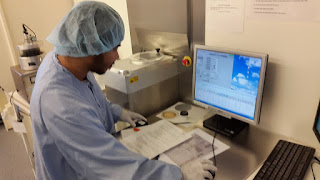San Diego, Calif – April 11, 2018–RASIRC announced today that the company will present at VCSEL Day 2018, held April 12-13, 2018 in Ulm, Germany. Jeffrey Spiegelman, RASIRC President and Founder, will present an alternative method for aperture oxidation. The annual event provides a European forum to discuss the state of the art and latest research. “Wafer to wafer and batch to batch oxidation uniformity are difficult challenges in VCSEL manufacturing,” said Mr. Spiegelman. “The use of an additional and stronger oxidant such as hydrogen peroxide gas with or without water vapor is an attractive approach. This can provide an additional control parameter in order to optimize uniformity for higher yields.”
RASIRC Peroxidizer® for High Concentration H2O2 Gas (left) and RASIRC BRUTE™ Peroxide for Ultra-Dry H2O2 Gas (right) please find more information here (LINK)
VCSELs are specialized laser-emitting semiconductors that are used in a wide variety of applications. VCSEL yield is directly related to the control during oxidation of aperture structure. Researchers have been challenged to identify additional methods to ensure uniformity. RASIRC has developed an innovative alternative that can provide better control of oxidation rate by adjustments in hydrogen peroxide concentration as well as lower process temperatures.
RASIRC’s Peroxidizer® and Hydrogen Peroxide Steamer (HPS) products provide high volumes of reactive H2O2/H2O mixtures for high throughput oxidation processes. These reactive gas generators are ideal for batch furnaces by providing the ability to vary concentration and flow rate, with or without the use of a carrier gas. Delivery into sub-atmospheric conditions is an additional feature.
RASIRC products also include the RainMaker Humidification System (RHS) that generates high precision water vapor for oxidation applications. This product has already proven to be useful in VCSEL manufacturing.
About RASIRC
RASIRC specializes in products that generate and deliver gas to fabrication processes. Each unit is a dynamic gas plant in a box—converting common liquid chemistries into safe and reliable gas flow for most processes. First to generate ultra-high purity (UHP) steam from de-ionized water, RASIRC technology can now also deliver hydrogen peroxide gas and hydrazine gas in controlled, repeatable concentrations. RASIRC gas delivery systems, humidifiers, and closed loop humidification systems are critical for many applications in semiconductor, photovoltaic, pharmaceutical, medical, biological, fuel cell, and power industries. Call 858-259-1220, email info@rasirc.com or visit http://www.rasirc.com.
Contacts:
RASIRC
Jeffrey Spiegelman
Phone: 858-259-1220
E-mail: jeff@rasirc.com
VCSELs are specialized laser-emitting semiconductors that are used in a wide variety of applications. VCSEL yield is directly related to the control during oxidation of aperture structure. Researchers have been challenged to identify additional methods to ensure uniformity. RASIRC has developed an innovative alternative that can provide better control of oxidation rate by adjustments in hydrogen peroxide concentration as well as lower process temperatures.
RASIRC’s Peroxidizer® and Hydrogen Peroxide Steamer (HPS) products provide high volumes of reactive H2O2/H2O mixtures for high throughput oxidation processes. These reactive gas generators are ideal for batch furnaces by providing the ability to vary concentration and flow rate, with or without the use of a carrier gas. Delivery into sub-atmospheric conditions is an additional feature.
RASIRC products also include the RainMaker Humidification System (RHS) that generates high precision water vapor for oxidation applications. This product has already proven to be useful in VCSEL manufacturing.
About RASIRC
RASIRC specializes in products that generate and deliver gas to fabrication processes. Each unit is a dynamic gas plant in a box—converting common liquid chemistries into safe and reliable gas flow for most processes. First to generate ultra-high purity (UHP) steam from de-ionized water, RASIRC technology can now also deliver hydrogen peroxide gas and hydrazine gas in controlled, repeatable concentrations. RASIRC gas delivery systems, humidifiers, and closed loop humidification systems are critical for many applications in semiconductor, photovoltaic, pharmaceutical, medical, biological, fuel cell, and power industries. Call 858-259-1220, email info@rasirc.com or visit http://www.rasirc.com.
Contacts:
RASIRC
Jeffrey Spiegelman
Phone: 858-259-1220
E-mail: jeff@rasirc.com



%20(1).png)

















